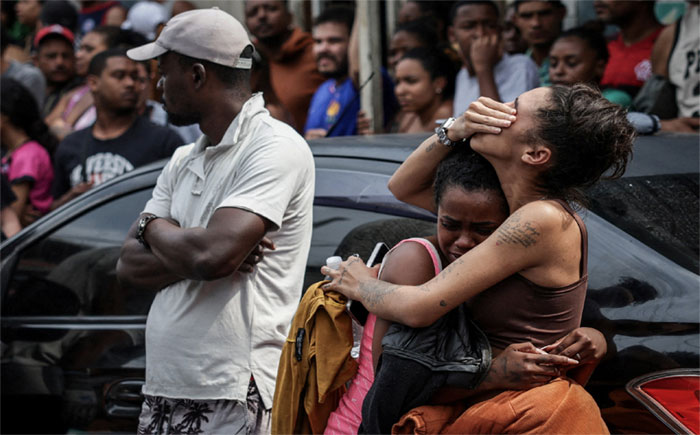
The first shots cracked at 4:47 a.m., moments before the sun peeled over the ridge of Complexo da Maré. By 9 a.m., the narrow alleys between the stilt houses looked like a war zone: spent rifle casings floating in open sewers, walls pock-marked by 50-calibre rounds, and rows of tarp-covered bodies on the hand-ball court where children usually play after school.
Police commanders called it Operation Alacrão (“Operation Rattle-Snake”)—a joint assault by 430 officers from Rio’s elite BOPE unit, civil police and federal highway troops. Official tally: 60 suspected gang members killed, two officers dead, four wounded. Human-rights groups call it the bloodiest police incursion in Brazilian history, surpassing the 28 deaths in Jacarezinho favela three years ago.
Investigation files seen by this paper show the raid aimed to capture Elias Pereira da Silva, alias “Mini-Mão”—a 27-year-old who ran cocaine, AR-15 rifles and even TikTok advertising for the Comando Vermelho across Maré’s 16 favelas. Police say Mini-Mão’s crew was behind last month’s ambush that killed two soldiers on the Red Line highway.
Yet when the smoke cleared, Mini-Mão was not among the 60 bodies. Security cameras at a nearby Texaco station show a silver pickup speeding away at 5:11 a.m.—two minutes after BOPE breached the first barricade. “He was tipped off,” a homicide detective admitted on condition of anonymity. “Someone inside the operation talked.”

A leaked internal briefing, stamped “Confidencial – 05Nov 00:45h”, instructs officers to “neutralise with maximum lethality any armed resistance” and reminds commanders that “courts understand the dynamics of high-risk operations”. Legal scholars say the wording edges close to a licence to shoot first, question later.
Witnesses back that up. Carla Nascimento, 34, saw her neighbour Anderson dos Santos, 22, shot while raising his hands. “He shouted, ‘I’m unarmed!’ They kept firing,” she said, showing mobile-phone footage of bodies on a blood-slick alley. Anderson’s family later discovered he had no criminal record; he worked nights at a nearby bakery.
Police classify all 60 dead as “suspects”, but at least nine bodies had no weapons recovered beside them, according to a preliminary autopsy log from the Instituto Médico Legal. One corpse was a 14-year-old girl, Eduarda Silva, caught in cross-fire while buying sugar for her mother. Investigators initially logged her as “female combatant”; the label was erased after reporters asked questions.
Several residents told this paper they saw officers drop pistols next to corpses. One video, verified by Forensic Architecture, shows a policeman in black balaclava placing a Taurus revolver near a hand already stiff with rigor mortis. Rio’s police union denies any wrongdoing, saying “in the heat of battle, guns move”.
Governor Cláudio Castro praised the raid as “a decisive blow against organised crime” and promised 200 new officers for Maré within weeks. President Jair Bolsonaro’s successor, Carlos Lupi, facing a surge in violent crime ahead of 2026 elections, tweeted: “Criminals must understand the State is stronger.”
But UN High Commissioner for Human Rights called for an independent inquiry, noting that Brazilian police already kill more civilians per year than any other country. Amnesty International counted 1,814 police fatalities in Rio alone from January to October 2025—an average of six per day.

Maré sits beside the Red Line, the highway linking the city to Galeão International Airport. Tour operators have lobbied for years to “clean up” the route. Property prices in nearby middle-class neighbourhoods jumped 18 % this year amid talk of pacification. Critics say the raid was as much about real-estate optics as drug routes.
This paper has obtained screenshots from a BOPE group chat dated 4 November. One message reads:
“Let’s make Maré an example—press will love it, stats will scare the small fish.”
Another officer replies:
“If we get 50+ it’s promotion season.” When contacted, military police command said the messages were “under investigation” and could be “deep-fake fabrications”.
By nightfall, bodies lay in three different hospitals, some tagged with duct-tape numbers, others with magic-marker initials. Families wandered between morgues clutching photos, searching for missing sons. DNA sampling only began 36 hours after the shooting—beyond the optimal window for accurate gun-residue tests.
- State prosecutor has opened a homicide review; officers involved must give statements next week.
- Federal Senate will hold a public hearing on 20 November; police chiefs and victims’ families have been summoned.
- IOC has asked for security guarantees ahead of the 2026 Rio Summer Youth Olympics; sponsors fear brand damage.
Operation Alacrão delivered the biggest body count in Brazil’s policing history, yet the top target escaped, civilian deaths mount, and hard evidence of summary executions keeps surfacing. For a city marketing itself as safe for tourists and investors, Maré’s blood-stained alleys are a reminder that Rio’s recipe for security still relies on bullets first, questions later—and the world is watching.
www.pepperroom.com.ng
#pepperroomnews #pepperroomng #pepperroom
Lagos, Nigeria.
+234 913 161 4181
+234 803 961 8550
+234 802 321 3873
info@pepperroom.com.ng
© 2025 | 🌶️Pepper-Room - Everything Loud, Wild, and Worth Talking About. | All Rights Reserved.
Pepper-Room is not responsible for the content of external sites.